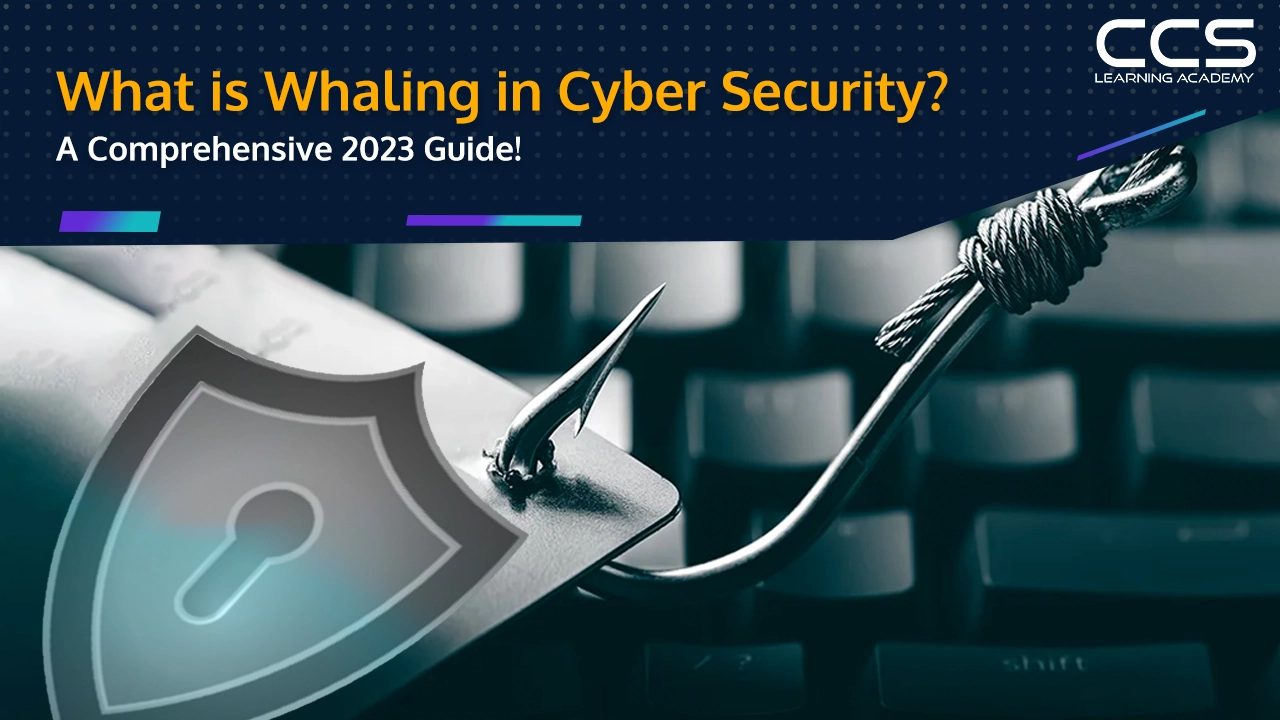What is Whaling in Cyber Security? A Comprehensive Guide!
- -
- Time -

In the vast ocean of cybersecurity threats, a new predator has emerged: whaling. This isn’t about hunting giant sea creatures but a sophisticated form of cyber attack targeting the “big fish” within organizations.
According to GreatHorn, an email security company, these attacks have risen by 131% compared to the same period in 2020. The company’s report further reveals that 59% of organizations have had an executive targeted for whaling attacks, and nearly half of those executives (46%) have succumbed to these attacks.
On average, targeted executives received whaling emails once every 24 days!
Table of Contents
- What is Whaling?
- Why is Whaling Dangerous?
- The Big Fish: Who Are They?
- How Does Whaling Work?
- Whaling vs. Other Cyber Attacks: A Targeted Approach
- Why is Whaling a Concern for Businesses & Organizations?
- Tactics and Techniques Used in Whaling Attacks
- Recognizing Whaling Attacks
- Mitigating the Risk of Whaling Attacks
- Incident Response and Recovery
- FAQs
What is Whaling?
Whaling is a specific type of cyber attack where cybercriminals target high-profile individuals within an organization, such as executives or senior management. These individuals are often referred to as the “big fish” or “whales” within the company, hence the name!
Why is Whaling Dangerous?
Whaling is particularly dangerous because of its targeted nature. Unlike generic phishing attacks that are sent to a large number of potential victims, whaling is tailored to a specific individual. The personalized approach makes the attack more convincing and increases the likelihood of success.
The Big Fish: Who Are They?
| Aspect | Description |
| High-Value Targets | The “big fish” refers to individuals who have significant influence, access to critical financial information, or the ability to authorize substantial transactions. |
| Why They’re Targeted | Their access to sensitive information makes them lucrative targets for attackers seeking financial gain or competitive advantage. |
| Potential Impact | A successful whaling attack on a top executive can lead to substantial financial losses, legal consequences, and reputational damage to the organization. |
How Does Whaling Work?
- Target Identification: The attacker identifies a high-profile target within an organization, such as a CEO, CFO, or other senior executives.
- Research and Reconnaissance: The attacker gathers detailed information about the target, including their work habits, interests, contacts, and even personal details. This information is often collected through social media, company websites, and other public sources.
- Crafting the Attack: Using the gathered information, the attacker crafts a highly personalized email or message that appears to come from a trusted source, such as a colleague, family member, or business partner.
- The Hook: The email or message typically contains a request or an urgent action that the target must take. This could be a financial transaction, clicking on a link, downloading an attachment, or providing sensitive information.
- The Catch: If the target falls for the bait and follows the instructions, they may inadvertently reveal sensitive information, transfer funds, or install malicious software on their system.
Deceptive Appearance
Emails in whaling attacks are often meticulously crafted to look like they come from trusted sources. This can include:
- Similar Email Addresses: For example, an email from “ceo@companny.com” instead of the legitimate “ceo@company.com.”
- Logos and Branding: Using the company’s logo, signature, and formatting to make the email look official.
Embedded Links or Attachments
These emails may contain dangerous elements that are designed to deceive and manipulate the target. Here’s a deeper look:
Malicious Links
These are links that are disguised to look legitimate but lead to fraudulent sites or actions:
- Fake Login Pages: For example, a link that appears to lead to a company portal but redirects to a fake login page to steal credentials.
- Hidden URL: The text of the link might say “www.yourbank.com,” but the actual hyperlink leads to a different, malicious site.
- Shortened URLs: Attackers may use URL shorteners to hide the true destination of the link, making it harder to recognize as malicious.
- Example: An email that appears to be from the IT department asking the target to reset their password, with a link leading to a fake password reset page.
Harmful Attachments
These are files attached to the email that contain malicious code or deceptive content:
- Disguised Files: An attachment might appear to be a PDF or Word document but is actually an executable file that installs malware.
- Invoice Scams: An attachment disguised as an invoice or receipt that the target supposedly needs to pay, but it contains malware that can infect the system.
- Macro-Enabled Documents: Documents that prompt the target to enable macros, which then execute malicious code on the target’s system.
- Example: An email that appears to be from a trusted vendor sending an invoice for a recent purchase, but the attached file contains ransomware that encrypts the target’s files.
Fake Websites
Mimicking Legitimate Sites
Attackers may create websites that are almost identical to legitimate sites:
- Banking Sites: A fake bank website that looks just like the target’s real bank, used to steal login information.
- Corporate Intranet: A replica of the company’s internal site to gather sensitive corporate data.
Purpose
These sites serve specific malicious purposes:
- Harvesting Credentials: Collecting usernames and passwords for later unauthorized access.
- Fraudulent Transactions: Tricking the target into authorizing payments or transfers to the attacker’s accounts.
Tailored Messages
Customized Content
Messages are often personalized to the target:
- Interest Alignment: If the target is known to be a dog lover, the email might include a fake invitation to a charity event for animal welfare.
- Project-Related Content: If the target is working on a specific project, the email might include requests related to that project, making it seem more authentic.
Emotional Manipulation
Understanding the target’s personal and professional life allows for emotional manipulation:
- Urgency: Crafting a message that a critical business decision needs to be made immediately, playing on the target’s sense of responsibility.
- Appeal to Emotions: If the target is known to support a particular cause, an email might request urgent donations to that cause, playing on empathy and compassion.
Whaling attacks are highly sophisticated and personalized to the individual target. By understanding these tactics and being vigilant, individuals and organizations can better protect themselves against these deceptive and potentially devastating attacks.
Whaling vs. Other Cyber Attacks: A Targeted Approach
| Aspect | Whaling Attacks | Other Cyber Attacks |
| Target Approach | Specific to individuals with influence or access to critical information | Casts a wide net, targeting anyone |
| Techniques Used | Sophisticated, including personalized emails, social engineering, manipulation | Generally less personalized |
| Stakes Involved | Higher stakes, with potential for significant financial or informational gains | Lower stakes, often with smaller gains |
Why is Whaling a Concern for Businesses & Organizations?
Whaling is a growing concern for organizations for several reasons:
Financial Risks
- Substantial Losses: Successful whaling attacks can lead to significant financial losses. Attackers often target high-ranking officials who have access to financial accounts or can authorize large transactions.
- Fraudulent Transfers: Attackers may impersonate a trusted entity to request money transfers, leading to unauthorized and often irretrievable financial transactions.
- Cost of Mitigation: Beyond the immediate financial loss, organizations may incur additional costs in investigating the breach, implementing new security measures, and recovering from the attack.
Reputational Damage
- Loss of Trust: Falling victim to a whaling attack can severely harm an organization’s reputation. Clients, partners and the general public may lose trust in the organization’s ability to safeguard information.
- Competitive Disadvantage: A damaged reputation can lead to a loss of competitive edge, as customers and partners may choose to work with perceived more secure alternatives.
- Long-term Impact: Rebuilding trust and reputation can be a slow and challenging process, with potential long-term impacts on business relationships and market position.
Legal Consequences
- Compliance Violations: If sensitive information is compromised in a whaling attack, it may lead to violations of data protection laws and regulations, such as GDPR.
- Legal Liability: Organizations may face legal liability for failing to protect sensitive information, leading to potential lawsuits from affected parties.
- Regulatory Penalties: Regulatory bodies may impose fines or other penalties on organizations that fail to comply with required security standards.
- Contractual Breaches: If the compromised information involves third-party agreements or client data, it may result in breaches of contractual obligations, leading to further legal complications.
B2B companies often deal with sensitive data and high-value transactions, making them attractive targets for whaling attacks.
One of the most famous breaches happened in the year 2015, when an aerospace company specializing in aircraft components and systems, lost $47 million after a successful ‘whaling’ attack. In this case, the hackers impersonated the CEO of FACC to get an employee to send money.
Tactics and Techniques Used in Whaling Attacks
Whaling attacks often employ various methods to deceive victims. Here’s a breakdown:
| Category | Technique | Description |
| Social Engineering Methods | Pretexting | Posing as a bank or service provider requires the target’s action. |
| Baiting | Promising an item or benefit to entice the target into providing information. | |
| Impersonation Techniques | Email Spoofing | Targeted emails that seem to come from a trusted source. |
| Website Cloning | fake websites closely resembling legitimate ones. | |
| Exploiting Psychological Factors | Urgency | Creating a sense of urgency, and pressuring the target to act quickly. |
| Authority | Impersonating someone in a position of authority to coerce compliance. |
Recognizing Whaling Attacks
Whaling attacks are targeted phishing attacks aimed at high-profile individuals within an organization. Recognizing them involves being alert to certain red flags:
Unexpected Requests
- Look for Context: If a request for sensitive information comes out of the blue, especially from a high-ranking official, it’s a red flag.
- Verify the Request: Always confirm such requests through a secondary communication channel, like a phone call to the person supposedly making the request.
Mismatched Email Addresses
- Inspect the Address: Sometimes, the display name may look legitimate, but the actual email address may be off by a letter or use a different domain.
- Use Email Security Tools: Implementing email security solutions that can flag suspicious email addresses can be helpful.
Grammar and Spelling Errors
- Scrutinize the Language: Professional communications are usually well-written. Look for inconsistencies, poor grammar, and spelling mistakes.
- Consider the Tone: If the tone doesn’t match previous communications from the sender, it might be a sign of a scam.
Mitigating the Risk of Whaling Attacks
Preventing whaling attacks is a multifaceted approach that requires both technological measures and human awareness:
Multi-Factor Authentication (MFA)
- How It Works: MFA requires two or more verification methods – something you know (password), something you have (a phone), or something you are (fingerprint).
- Benefits: Even if an attacker obtains a password, they would still need the second factor, making unauthorized access much more difficult.
Strong Passwords
- Encourage Complexity: Use a mix of letters, numbers, and special characters. Avoid common words or phrases.
- Implement Password Policies: Enforce regular password changes and prevent the reuse of old passwords.
- Use Password Managers: Encourage the use of password managers to create and store complex passwords securely.
Education and Training
- Regular Training: Educate employees about the risks of whaling attacks and how to recognize them.
- Simulated Attacks: Conduct simulated whaling attacks to test employees’ awareness and response.
Regular Monitoring and Audits
- Monitor for Suspicious Activity: Implement tools that can detect unusual patterns or behaviors within the network.
- Conduct Security Audits: Regularly assess the security measures in place to ensure they are up-to-date and effective.
- Regular Training: Educate employees about recognizing whaling tactics.
Organizations can substantially lower the risk of succumbing to whaling attacks by integrating technological solutions with relentless education and alertness. This approach is not a one-time fix but a fluid process that demands constant effort and flexibility to adapt to the ceaselessly evolving landscape of threats.
Incident Response and Recovery
When a whaling attack occurs, time is of the essence, and an immediate response is vital!
Containment: Isolate Affected Systems
- Immediate Action: As soon as a breach is detected, the affected systems must be isolated to prevent further damage. This includes disconnecting them from the network and other interconnected systems.
- Long-term Strategy: Implementing containment measures to prevent future attacks, such as firewalls, intrusion detection systems, and regular monitoring.
Investigation: Understand How the Breach Occurred
- Identify the Source: Determine how the attackers gained access. This could involve analyzing logs, tracing back connections, and identifying vulnerabilities that were exploited.
- Assess the Damage: Understand what data was compromised and the extent of the breach. This helps in legal compliance and future prevention.
- Collaborate with Experts: Often, specialized cybersecurity experts are brought in to conduct a thorough investigation.
System Restoration: Restore Systems from Secure Backups
- Evaluate the Backups: Ensure that the backups are secure and free from any malware or compromised data.
- Restore the Systems: Utilize the secure backups to restore the affected systems to their pre-attack state.
- Monitor for Anomalies: Continuous monitoring after restoration is essential to ensure that no remnants of the attack remain in the system.
Security Enhancement: Strengthen Security Measures Based on the Findings
- Implement New Measures: Based on the findings from the investigation, new security measures may be implemented, such as patching vulnerabilities, updating software, and enhancing authentication protocols.
- Educate Employees: Training staff on recognizing and responding to phishing and whaling attacks can be a crucial preventive measure.
- Regular Audits and Assessments: Continuous evaluation of security protocols and regular penetration testing can help in identifying potential weaknesses before they can be exploited.
Whaling is a significant threat to B2B companies. By understanding the nature of whaling and implementing effective strategies, businesses can protect themselves from these sophisticated forms of cyber attack.
If you’re concerned about the rise in whaling attacks and want to equip yourself or your organization with the knowledge and skills to combat them, don’t miss the cybersecurity courses offered by CCS Learning Academy.
Our specialized Cybersecurity Awareness Training is designed to empower individuals and businesses to stay ahead of cyber threats. Learn more and take the first step towards a secure digital environment by visiting CCS Learning Academy today.
Stay safe, stay informed!
FAQs
What is a whaling attack in cybersecurity?
Whaling attacks target high-ranking individuals within organizations, like CEOs or CFOs.
How does whaling differ from phishing?
Unlike phishing, whaling is highly targeted and involves extensive research on the victim.
Why are B2B companies targeted in whaling attacks?
B2B companies often deal with sensitive data and high-value transactions, making them attractive targets.
What are some common tactics used in whaling attacks?
Tactics include social engineering, impersonation techniques, and exploiting psychological factors.
How can organizations recognize a whaling attack?
Recognizing common red flags like unexpected requests, mismatched email addresses, and grammar errors can help.
What are the best practices to mitigate whaling attacks?
Implementing MFA, strong passwords, and regular employee training are key strategies.
How should a company respond to a whaling attack?
Immediate containment, investigation, system restoration, and security enhancement are crucial steps.
What are the motivations behind whaling attacks?
Motivations often include financial gain, industrial espionage, and reputational damage.
How can technology assist in recognizing whaling attacks?
Utilizing advanced technologies like email security solutions and AI can significantly improve detection capabilities.
What’s the future of whaling attacks?
With advancements in AI and remote work, whaling attacks are likely to become more sophisticated and harder to detect.






